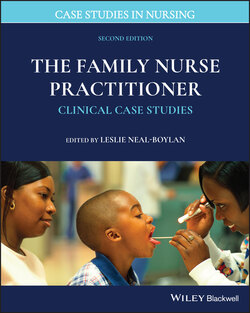Читать книгу The Family Nurse Practitioner - Группа авторов - Страница 38
ОглавлениеCase 4.7 Left Arm Pain
By Mikki Meadows‐Oliver, PhD, RN, FAAN
SUBJECTIVE
Jair, a 11‐month‐old infant, presents to the primary care office with a complaint of not using his left arm for one day. He is accompanied by his parents. His father states that Jair fell off the couch yesterday and he thinks that Jair may have landed on his left arm. The history provided by his mother is somewhat different. She states that Jair fell down two stairs while in a walker and hurt his left arm at that time.
Birth history: Jair was born at 35 weeks’ gestation. His birth weight was 2200 g. There were no complications during the labor or delivery. The mother had no infections, falls, or known exposures to environmental hazards. She did not drink alcohol, take prescription medication (other than prenatal vitamins), use tobacco products, or use illicit drugs. Jair was discharged after 4 weeks in the neonatal intensive care unit to home with his mother.
The social history reveals that Jair was born to a adolescent single mother. His father, 18 years old, is involved but does not reside in the household. Jair lives in an apartment with his mother and 19‐year‐old cousin. The maternal grandmother (MGM) lives in the neighborhood and is able to help Jair’s mother with child care. The family receives assistance from governmental subsidies such as the Women, Infants, and Children (WIC) supplemental nutrition program, Temporary Assistance for Needy Families (TANF), and Medicaid. Educationally, both Jair’s mother and father have high school diplomas. She works at a fast‐food restaurant. Joseph’s father works as a construction worker. The family has no pets. There are no smokers in the home.
Diet: Jair eats a balanced diet of table foods. He is transitioning from formula to whole milk. He takes a daily multivitamin.
Elimination: 4–6 wet diapers daily with 1 bowel movement.
Sleep: Takes one 2‐hour nap daily and sleeps 12 hours at night.
Family medical history: Paternal grandfather (age 54): healthy; paternal grandmother (age 53): hypertension; maternal grandfather (age 46): hypothyroidism; MGM (age 44): Type 2 diabetes; mother (age 18): asthma; father (age 18): healthy.
Medications: Currently taking no prescription, herbal, or over‐the‐counter medications.
Immunizations: Up to date.
Allergies: No known allergies to food, medications, or environment.
OBJECTIVE
Vital signs: Weight: 10 kg; length: 84 cm; temperature: 37°C (axillary).
General: Alert; well nourished; well hydrated; interactive.
Skin: Right side of forehead with ecchymosis and a 2 cm abrasion; no other lesions noted. No cyanosis of lips, nails, or skin; no diaphoresis noted; good skin turgor.
Head: Normocephalic; anterior fontanel is open and flat (1 cm × 1 cm).
Eyes: Red reflexes present bilaterally; pupils equal, round, and reactive to light; no discharge noted.
Ears: Pinnae normal; tympanic membranes gray bilaterally with positive light reflex.
Nose: Both nostrils are patent; no discharge.
Oropharynx: Mucous membranes are moist; 4 teeth are present; no lesions.
Neck: Supple; no nodes.
Respiratory: RR = 24; clear in all lobes; no adventitious sounds noted; no retractions; no deformities of the thoracic cage noted.
Cardiac/Peripheral vascular: HR = 100; regular rhythm. No murmur noted.
Abdomen/Gastrointestinal: Soft, nontender, nondistended, no evidence of hepatosplenomegaly.
Genitourinary: Normal circumcised male genitalia; testes descended bilaterally.
Back: Spine straight.
Ext/Musculoskeletal: Left arm with limited range of motion and tenderness to touch over left clavicle and left humerus. Both tender areas are slightly swollen and erythematous. Full range of motion of all other extremities; warm and well perfused; capillary refill < 3 seconds in all extremities.
Neurologic: Good strength and tone.
CRITICAL THINKING
1 Which diagnostic or imaging studies should be considered to assist with or confirm the diagnosis?___Radiograph of left arm/clavicle___CBC___Metabolic panel
2 What is the most likely differential diagnosis and why?___Fracture of left arm/clavicle to accidental fall___Physical abuse___Osteogenesis imperfecta
3 What is the plan for treatment, referral, and follow‐up care?
4 Are there any referrals needed?
5 Does the patient’s psychosocial history impact how you might treat him?
